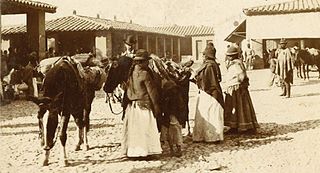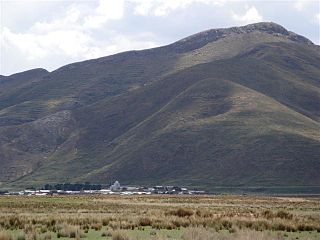
The Aymara or Aimara people are an indigenous people in the Andes and Altiplano regions of South America; about 2.3 million live in northwest Argentina, Bolivia, Chile, and Peru. Their ancestors lived in the region for many centuries before becoming a subject people of the Inca in the late 15th or early 16th century, and later of the Spanish in the 16th century. With the Spanish American Wars of Independence (1810–1825), the Aymaras became subjects of the new nations of Bolivia and Peru. After the War of the Pacific (1879–1883), Chile annexed territory with Aymara population.

Sandia Province is a province of the Puno Region in Peru. The capital of the province is the city of Sandia.
Kenko,Qenqo or Q'inq'u or also Inka Anatawi is an archaeological site in Peru. It is located in the Puno Region, Puno Province, Acora District, at an elevation of about 4,000 m (13,000 ft). The site was declared a National Cultural Heritage (Patrimonio Cultural) of Peru by the National Institute of Culture.
Mallkuamaya is an archaeological site in Peru. It is located in the Puno Region, Puno Province, Puno District, about 15 km southwest of Puno. The site was declared a National Cultural Heritage (Patrimonio Cultural) of Peru by the National Institute of Culture.
Intini Uyu Pata or Inti Uyu is an archaeological site in Peru. It is located in the Puno Region, Yunguyo Province, between the districts Ollaraya and Unicachi, at a height of about 3,867 m (12,687 ft). The site was declared a National Cultural Heritage (Patrimonio Cultural) of Peru by the National Institute of Culture.
Mirq'imarka is an archaeological site in Peru. It is located in the Puno Region, Moho Province, Moho District. The site was declared a National Cultural Heritage (Patrimonio Cultural) of Peru by the National Institute of Culture.
Molloko is an archaeological site in Peru. It is located in the Puno Region, Puno Province, Acora District, about 5 km south of the town of Acora, near the village of Molloco. The site was declared a National Cultural Heritage (Patrimonio Cultural) by the National Institute of Culture.
Pumamarka (Aymara and Quechua puma cougar, puma, marka village, "puma village", is an archaeological park in Peru. It is located in the Cusco Region, Cusco Province, San Sebastián District, on the left side of the river Pumamarka. The site was declared a National Cultural Heritage of Peru by the National Institute of Culture.

Pucará, Puno is a town in the Puno Region, Lampa Province, Pucará District, Peru. It is located to the north-west of Lake Titicaca.
Tanqa Tanqa or Tanka Tanka is an archaeological site in Peru. It is located in the Puno Region, Chucuito Province, Zepita District. The site was declared a National Cultural Heritage (Patrimonio Cultural) of Peru.
Taqrachullu, Pukara Taqrachullu, T'akrachullu, Pukara T'akrachullu or María Fortaleza is an archaeological site in Peru. It is located in the Cusco Region, Espinar Province, Suykutambo District.

Khapia is a mountain in Peru, possibly an extinct volcano, situated at a height of about 4,809 metres (15,778 ft). It is located in the Puno Region, Chucuito Province, in the districts Pomata and Zepita, and in the Yunguyo Province, in the districts Cuturapi, Copani and Yunguyo. The mountain lies near Lake Titicaca at the road which connects Yunguyo and Puno, south of the hill Asiru Phat'jata.

Uyu Uyu is an archaeological site in Peru. It lies in the Arequipa Region, Caylloma Province, Yanque District, on the right bank of the Qullqa River.
Paraccra is an archaeological site in the Andes of Peru on a mountain of the same name. It is situated in the Arequipa Region, Caylloma Province, Sibayo District, near the Colca River. The site contains towers, round houses and black walls.
Wila Wilani is an archaeological site with rock art in Peru. It is located in the Tacna Region, Tacna Province, Palca District, near Wila Wilani (Vilavilane, Vilavilani). The motives of the paintings are predominantly hunting scenes with camelids.

Pukarani is a mountain with an archaeological site of the same name in the Andes of Peru, about 4,301.9 m (14,114 ft) high. It is located in the Puno Region, Lampa Province, Nicasio District.
Pirca Pirca is an archaeological site in Peru. It is located in the Lima Region, Yauyos Province, Tanta District. Pirca Pirca was declared a National Cultural Heritage of Peru by Resolución Viceministerial No. 011-2013-VMPCIC-MC on February 7, 2013. It lies north of Lake Paucarcocha.
Qala K'umu is a mountain in the north of the Apolobamba mountain range in the Andes of Peru, about 5,200 metres (17,060 ft) high. It is located in the Puno Region, Putina Province, Ananea District, northwest of La Rinconada. Qala K'umu lies southwest of the mountains Wilaquta, Qachini and Qurwari.
Wila Wilani or Ch'ankha Qullu is a mountain in the Andes of southern Peru, about 4,900 metres (16,076 ft) high. It is located in the Moquegua Region, Mariscal Nieto Province, Carumas District, and in the Tacna Region, Candarave Province, Candarave District. It lies west of a lake named Aqhuya Ch'alla, northwest of Paxsi Awki and east of Churi Laq'a, Ch'alluma and Ch'ankhani.
Mullu Q'awa is an archaeological site in Peru on a mountain of that name. It is located in the Cusco Region, Espinar Province, Alto Pichigua District. It lies near the village of Mullu Q'awa (Molloccahua, Molloqhawa). It is situated on top of the mountain at a height of about 4,000 m (13,000 ft).







